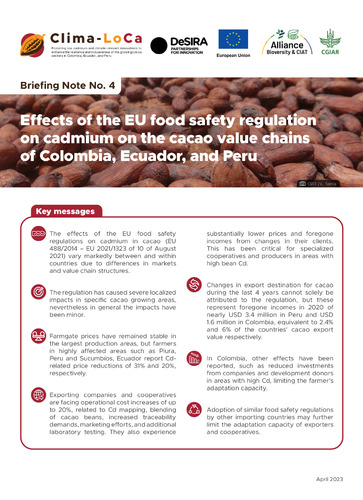Effects of the EU food safety regulation on cadmium on the cacao value chains of Colombia, Ecuador, and Peru
This briefing note combines information from three country reports conducted between 2021 and 2022, as well as relevant findings from the available literature to examine the current state of knowledge of the spatial distribution of Cd content in cacao farms in the three countries, how the EU regulation has affected different stakeholders, and how they are managing the problem. With the information presented in this document, we also improve and update literature available to date.
The effects of the EU food safety regulations on cadmium in cacao (EU 488/2014 – EU 2021/1323 of 10 of August 2021) vary markedly between and within countries due to differences in markets and value chain structures. The regulation has caused severe localized impacts in specific cacao growing areas, nevertheless in general the impacts have been minor.
Exporting companies and cooperatives are facing operational cost increases of up to 20%, related to Cd mapping, blending of cacao beans, increased traceability demands, marketing efforts, and additional laboratory testing. They also experience substantially lower prices and foregone incomes from changes in their clients. This has been critical for specialized cooperatives and producers in areas with high bean Cd.
Changes in export destination for cacao during the last 4 years cannot solely be attributed to the regulation, but these represent foregone incomes in 2020 of nearly USD 3.4 million in Peru and USD 1.6 million in Colombia, equivalent to 2.4% and 6% of the countries’ cacao export value respectively.
Adoption of similar food safety regulations by other importing countries may further limit the adaptation capacity of exporters and cooperatives.

